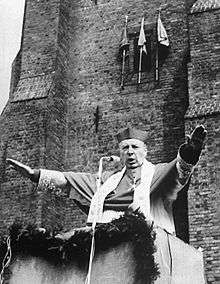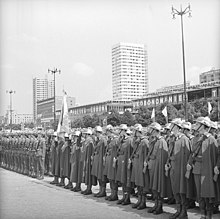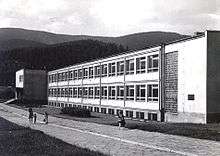Millennium of the Polish State
The Millennium of the Polish State (Polish: Tysiąclecie Państwa Polskiego, literally A Thousand Years of the Polish State) was a national celebration of the Christianization of Poland and the subsequent establishment of the first Polish nation. The celebrations took place over the years 1960–1966 by a resolution of the Sejm in 1958. The inauguration of the jubilee celebrations took place at the plenary session of the National Committee of the Unity Front on 16 February 1960 in Kalisz. The jubilee celebrations were accompanied by the educational program One thousand schools for the 1000th anniversary during which in the years 1959–1972 nearly 1.5 thousand schools were built.[1] It was decided to use the anniversary by both the hierarchy of the Catholic Church and the Polish United Workers' Party) for the propaganda in Poland. The church planned the celebration of the millennium of the baptism of Poland while the state authorities strictly commemorated the jubilee of the beginnings of the Polish nation.

Varying interpretations of the anniversary
The anniversary was interpreted in various ways depending on context. While most of the diaspora and the religious Catholic community celebrated the introduction of Christianity in Poland, the Communist-led government of the Polish United Workers' Party (PZWP), which pursued a state policy of atheism, sought to undermine the international celebrations be re-conveying the anniversary as an anniversary of the birth of the Polish nation. In doing so, the PZWP framed the celebrations as a secular and political anniversary instead of a religious one. This specifically caused friction between the PRL and the Vatican, which resulted in the twice denyal of Pope Paul VI to visit Poland in 1966. As British-Polish historian Norman Davies noted, the Church and the PZWP had "rival, and mutually exclusive, interpretations of [Poland's baptism] significance."[2]
Commemorations
Commemorative Coins
Commemorative coins were issued in connection with the celebrations. Their designs were prepared for a competition announced by the National Bank of Poland in 1957. As a result of the decision, it was decided the following year that the 10 złotych note designed by Józef Gosławski with the image of Mieszko I and Princess Doubravka as a 100-złotych silver commemorative coin.[3] It became one of the most expensive coins of the Polish People's Republic and was in the 70s in the Biuletyn Numizmatyczny magazine named "The Most Beautiful Polish Coin". By decree of the President of the Polish Government in Exile August Zaleski of 1 July 1966, it was decided to mint a commemorative Medal of the Millennium of Christian Poland.[4] On 30 July 1966, the U.S. Bureau of Engraving and Printing issued over 100,000,000 commemorative stamps in honor of the millennium anniversary.[5]
Tour of Cardinal Wyszynski

In 1966, Cardinal Primate Stefan Wyszynski traveled all over the country, visiting every region, during which he was welcomed by tens and hundreds of thousands of people. During the celebration, the authorities refused to allow Wyszyński from attending overseas celebrations. Each church in Poland posted slogana such as Sacrum Poloniae Millenium (Poland's Sacred Millennium) as well as Poloniae semper fidelis (Always loyal to Poland) and People with the Church (Naród z Kościołem). On 15 May 1966, in St. Peter's Basilica in Rome, Bishop Vladislav Rubin, a delegate from Cardinal Primate, sent papal mass in honor of the Polish Church Province. While reading a sermon in Gniezno, Cardinal Vyshinsky made this appeal: "I sincerely want you to firmly look at the past and present and, learning to love the history of this Christian people, look with open eyes at its Catholic essence".[6]
Anniversary parade

An anniversary Millennium Parade (Defiladzie Tysiąclecia) was held on 22 July 1966 to coincide with the annual National Day of the Rebirth of Poland celebrations (set on the anniversary of the signing of the PKWN Manifesto).[7][8] Like most military parades during that era, it was held in front of a grandstand near the Palace of Culture and Science on Parade Square. It was attended by Władysław Gomułka[9], the then First Secretary of the Polish United Workers' Party, as well as members of the PZWP and the Polish Council of State and the Sejm.[10] The parade saw thousands of troops of the Polish People's Army's three service branches march down the square. The parade inspector was Marshal of Poland Marian Spychalski, presiding as the Minister of National Defence. The parade commander who gave its commands and directions was Major General Czesław Waryszak (1919-1979), the commander of the Warsaw Military District. Both Marshal Spychalski and General Waryszak greeted the troops on parade with a single Czolem Żołnierzy (the Polish language version of Greetings Soldiers). It parade featured units such as the Representative Honor Guard of the LWP and the Band of the LWP (led by Colonel Lisztok), both of which provided ceremonial honors speicifacally. It uniquely featured cadets of military academies and other ceremonial units dressed in Polish historical military uniforms dating back to the Piast dynasty.[11][12] Some of the eras and events represented were the Knights of Bolesław I the Brave, the Battle of Grunwald and the Polish Armed Forces in the East. The Polish Aie Force also performed a flyover in the shape of a Piast Eagle The parade is today regarded as the largest military parade in the history of Poland.[13] It was also the cumilation of all events related to the anniversary.
Youth Rally
Over 25,000 Polish youth took part in a youth rally in the capital.[14] The manifestations were sponsored by the Polish Socialist Youth Union.
Closing Ceremony
The closing ceremony of the Millennium celebrations was held at the Congress of Polish Culture on 7-9 October 1966 in Warsaw, which was attended by writers, scientists and activists from all over the country.[15]
Places/Memorials

Parks
- Gopło Millennium Park
- Nadgoplański Millennium Park
- Millennium Park in Krakow
- Millennium Park in Leszno
- Millennium Park in Poznań
- Millennium Park in Sosnowiec
- Millennium Park in Toruń
- Millennium Park in Wroclaw
- Millennium Park in Zielona Góra
Districts
- Osiedle Tysiąclecia, Bełchatów
- Osiedle Tysiąclecia, Biała Podlaska
- Osiedle Tysiąclecia, Białystok
- Osiedle Tysiąclecia, Dąbrowa Górnicza
- Osiedle Tysiąclecia, Gdańsk
- Osiedle Tysiąclecia, Gnieźnie
- Osiedle Tysiąclecia, Jastrzębie-Zdrój
- Osiedle Tysiąclecia, Katowice
- Osiedle Tysiąclecia, Koszalin
- Osiedle Tysiąclecia, Kraków
- Osiedle Tysiąclecia, Myślenice
- Osiedle Tysiąclecia, Płock
- Osiedle Tysiąclecia, Poznań
- Osiedle Tysiąclecia, Prudnik
- Osiedle Tysiąclecia, Radomsko
- Osiedle Tysiąclecia, Siedlce
- Osiedle Tysiąclecia, Stargard
- Osiedle Tysiąclecia, Zielonej Górze
- 1000 Years District in Olkusz
- 1000 Years District in Poniatowa
- 1000 Years District in Rzeszów
- 1000 Years District in Tomaszów Mazowiecki
- 1000 Years District in Wejherowo
- 1000 Years District in Władysławowo
- 1000 Years District in Września
Streets/Public spaces
- Aleja Tysiąclecia
- Plac Tysiąclecia, Siedlcach
Buildings
- Millenium School
- 1000th-Anniversary of Polish State Stadium
Awards
The Badge of the 1000th anniversary of the Polish State (Odznaka 1000-lecia Państwa Polskiego) was unveiled in 1960 by the National Committee of the Unity Front of the Nation to distinguish individuals or organizations for their participation in social activities in connection to the celebration of the Millennium of the Polish State.[16][17][18]
The following individuals have been awarded with the badge:
- Elżbieta Barszczewska
- Jacek Woszczerowicz
- Wieńczysław Gliński
- Ignacy Gogolewski
- Wiesław Gołas
- Kazimierz Dejmek
See also
References
- Słownik 1970.
- Norman Davies (30 March 2005). God's Playground: The origins to 1795. Columbia University Press. pp. 15–17. ISBN 978-0-231-12817-9. Retrieved 5 April 2012.
- "Polish złoty". kiwix. kiwix.org. Archived from the original on 2012-04-26. Retrieved 3 January 2012.
- https://fastbox.su/tysi-clecie-polski-chrze-cija-skiej-srebrny-unikat-item-i7481374246.html
- U.S. #1313 Polish Millennium MNH Archived 14 April 2015 at the Wayback Machine
- Millenium Poloniae Christianae, 966—1966. // Rome: Centralny Ośrodek Duszpasterstwa Emigracji. — 1966. — p. 335
- http://wyborcza.pl/5,140981,19910958.html?i=6&disableRedirects=true
- Publicznej, Instytut Pamięci Narodowej--Komisja Ścigania Zbrodni przeciwko Narodowi Polskiemu Biuro Edukacji (December 6, 2006). "Biuletyn Instytutu Pamięci Narodowej". Instytut – via Google Books.
- Mazur, Mariusz (December 6, 2004). "Polityczne kampanie prasowe w okresie rządów Władysława Gomułki". Lubelskie Tow. Naukowe – via Google Books.
- "Niesamowita Defilada Tysiąclecia. Tak to wyglądało w 1966 [WIDEO] | Warszawa W Pigułce". August 16, 2015.
- http://www.kronikarp.pl/pop-up.php?id=58989&type=2
- "MySQL Fatal Error". phistory.info.
- https://www.polityka.pl/tygodnikpolityka/historia/1668606,1,jak-wygladala-najwieksza-parada-wojskowa-w-historii-polski.read
- Agency, United States Central Intelligence (December 6, 1966). "Daily Report, Foreign Radio Broadcasts" – via Google Books.
- Tadeusz Łepkowski, Słownik historii Polski. Warszawa 1973, s.505
- "Wyróżnienie dla sanockich harcerzy". 12 October 1966.
- asnieg.klub.chip.pl
- https://www.warszawa.ap.gov.pl/1000_lecie/12.html
External links
| Wikimedia Commons has media related to Millennium of Poland. |
- Polska Kronika Filmowa – Defilada Tysiąclecia – Warszawa 22 lipca 1966 r.
- CAŁA DEFILADA TYSIĄCLECIA PAŃSTWA POLSKIEGO/MILLENNIUM OF THE POLAND - PARADE (1966)
- Polish Millenium Parade 966 - 1966 (English subtitles)
- Milenium czy tysiąclecie?
- PRL: Monety obiegowe. Tysiąclecie Państwa Polskiego – Mieszko i Dąbrówka, nominał